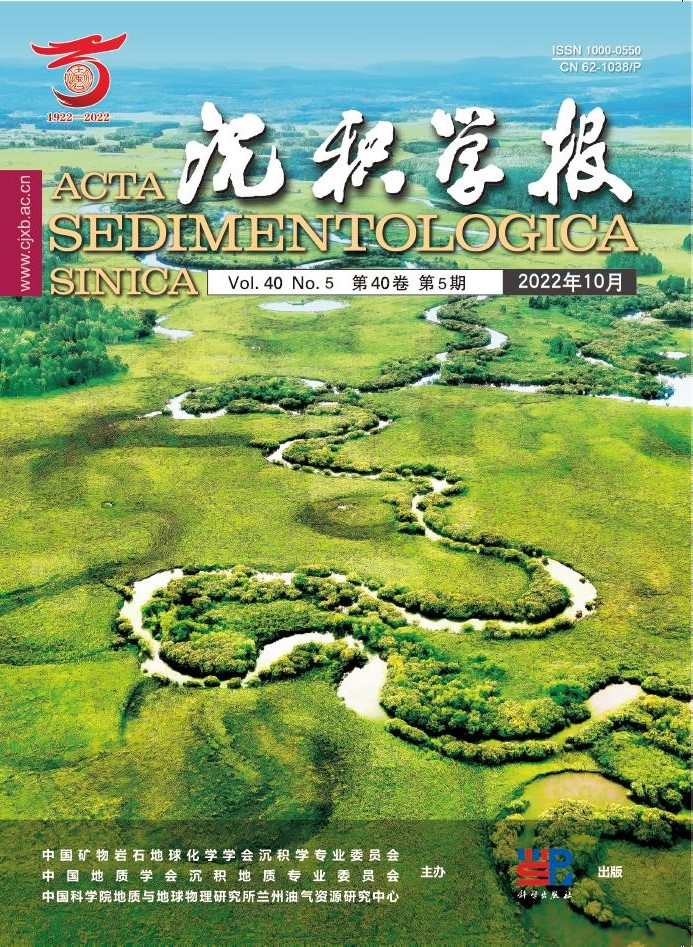HTML
-
微生物因数量巨大、分布广泛和类型多样在地球演化中发挥极其关键的作用,自寒武纪生命大爆发到奥陶纪是微生物生长发育最为富集、活跃的时期,引起地质学家的广泛关注和思考[1-8]。与此同时,全球范围内不断有与微生物碳酸盐岩相关的油气田被勘探发现,其中,位于我国西部塔里木盆地寒武系深层微生物丘也成为了勘探的热点[5-8]。微生物丘是指由藻类或菌类微生物岩形成的碳酸盐岩局部建隆,作为新型的碳酸盐岩油气储层,由于其独特的沉积建造和演化过程,成为碳酸盐岩油气研究的重要方向,也是深层找寻商业油气的重要领域。2020年,在塔里木盆地部署的亚洲第一深探井—轮探1井在寒武系微生物丘储层中获得高产轻质原油,证实了微生物丘沉积体是有利的勘探目标,具有极大的油气潜力。
寒武系为塔里木盆地最古老的沉积地层,盆地东部广大地区寒武系处于开阔台地沉积环境,在台缘带广泛发育的微生物丘复合体,为(超)深层油气优质储层的主要载体[9-10]。现阶段基于不同品质的资料和研究手段,人们对微生物丘体沉积结构及形成环境开展了一定程度的研究[4-11]。然而,由于寒武系深层钻井资料稀少、地震资料品质差、勘探成本居高等原因,目前对寒武系往往只开展盆地尺度的构造—岩相古地理研究,且编图往往以统为单位[12-15],较少涉及微生物丘发育期次、叠置样式及生长演化过程分析,制约了微生物丘的储层预测精度和勘探部署。
因此,本文以塔东南地区寒武系微生物丘为例,综合利用岩心、测井、分析测试和高精度三维地震数据,在微生物丘沉积特征分析基础上,探讨研究区微生物丘发育期次及叠置样式,进一步总结微生物丘的生长发育、迁移演化特征,以期为深层微生物丘油气勘探决策提供指导。
-
塔里木盆地是在前震旦纪变质岩之上,经历了多期次构造—沉积演化而形成的大型复合式叠合盆地[4]。塔东南地区位于盆地东南部的古城低凸起以东地区,为一持续继承性隆起,呈现向西北倾斜的大型宽缓鼻状构造[2-5]。北部为平缓斜坡向满加尔坳陷过渡,西部以塔中I号断裂为界与塔中隆起相邻,南部与塘古孜巴斯凹陷和塔南隆起相接,东部以古城台缘坡折带为界毗邻塔东隆起(图1a)。塔里木盆地寒武纪—早奥陶世处于弱伸展的构造背景下,西部为台地相区,为碳酸盐岩沉积环境,而东部盆地相区沉积了暗色泥岩,塔东南地区处于台缘相带,为微生物丘广泛发育提供广阔空间[3-7]。奥陶纪末构造活动形成古城凸起的雏形,总体上为东南高、西北低的构造形态,并于海西早期定形至今。

Figure 1. (a) Structural unit divisions in southeastern Tarim Basin; and (b) Cambrian composite column diagram
研究区块处于塔东南地区古城低凸起东侧,三维工区面积约4 000 km2,钻井揭示古城地区沉积厚度巨大,自震旦系到第四系均有发育,寒武系为深层油气勘探的重点层系,岩性为碳酸盐岩,细分为6个组。其中下统的玉尔吐斯组为厚层黑色泥岩、泥灰岩沉积,全盆分布稳定,为深层优质烃源岩。中、上寒武统发育多套储盖组合,储层岩性主要为藻(礁)微生物云岩(图1b)。
-
研究区中、上寒武统发育多期微生物丘沉积,目前仅有CT1、CT2两口探井钻遇。利用研究区少量钻井的岩心、测井和分析测试资料,分析微生物丘的岩性构成、储集性及分布特征,将微生物丘划分为丘核、丘翼和丘基三种微相类型。
-
在丘基之上、微生物丘中部形成厚层、丘状沉积。钻井揭示岩性为砂屑球粒粉晶云岩、砂屑细晶云岩或残余鲕粒砂屑云岩,粒度变粗。去铀GR值较低,变化范围为1.21~11.75 API,平均约2.94 API,曲线形状由高幅尖峰状变为低缓平值状。δ13C自下而上数值由正偏逐渐变换为负偏,变化范围为-1.05‰~0.29‰,平均-0.226‰,表明海平面下降,水体变浅、能量较强的沉积环境。此外,该期微生物丘核部顶端GR能谱测井的TH/U比急剧变大(大于7),揭示顶部为氧化环境形成的风化层,反映了海退环境下微生物丘核部暴露遭受剥蚀作用。储层岩性为球粒或砂屑粉、细晶云岩,在溶塌角砾岩中发育角砾间的溶蚀孔洞或裂缝。储层孔隙度范围在1.3%~7.2%之间,平均约3.4%,渗透率为(0.06~3.62)×10-3 μm2,为中低孔、中低渗性储层(图2,3)。
-
在微生物丘合成记录标定及地震反射特征分析基础上,对其外部形态和内幕结构进行精细识别和刻画,预测微生物丘展布特征。与围岩相比,微生物丘复合体垂向上表现为地层厚度显著变大,横向上出现多期微生物丘沉积体横向迁移叠置,大小不一,地震相表现为明显的丘状、楔状或透镜状[16-18]。丘复合体速度高于上覆的围岩,顶界面处形成强的波阻抗差,对应强波峰反射,而向海盆方向出现极性反转或者同相轴尖灭现象,反映了向海洋一侧生长推进的边界,具有包络面的特征。因此通过微生物丘标定和地震反射结构分析,采用振幅包络面分析的方法,理清微生物丘的外部轮廓和分布范围。
微生物丘的振幅包络面多表现为中—强振幅、连续—较连续反射,包络面之上、之下和内部反射特征明显,易于识别和追踪。界面之上常见披覆和上超反射,界面之下局部有顶超或削截的接触关系。而包络面内部为低频、较弱振幅、前积或局部杂乱反射,并具有向翼部收敛。通过上述特征对微生物丘的顶界振幅包络面(Ty1、Ty2、Ty3、Ty4)进行精细追踪解释,不难发现,中、上寒武统发育了4个期次的大型微生物丘复合体(图4a,b)。通过不同期次微生物丘预测范围立体展示,清楚的看到微生物丘依次向广海方向进积。叠合范围大于1 400 km2,平面上近南北向、条带状展布(图4c)。
-
微生物丘多由藻类或菌类微生物格架形成,其内部地震反射振幅能量弱,多为断续、空白或杂乱结构[18]。然而在微生物原地生长过程中,由于古地貌和相对海平面变化会出现丘、滩互层,垂向上会出现多种叠置样式,如加积、进积或退积等[19]。根据上述特点,分析研究区中、上寒武统微生物丘的发育期次及叠置样式(图5、表1)。
期次 地质时期 厚度范围/m 平均厚度/m 东西向宽度/km 平均宽度/km 构造埋深/m ④期 晚寒武世晚期 80~560 320 2.3~8.1 4.4 6 300~7 625 ③期 晚寒武世早期 130~580 360 5.8~9.2 7.1 6 500~7 750 ②期 中寒武世晚期 120~600 380 7~15.3 10.4 6 650~7 625 ①期 中寒武世早期 220~660 400 6.8~12.1 9.5 7 025~8 300
-
顶界面为低频、强振幅和高连续反射,区域分布稳定,所构成的包络面形态完整、轮廓清楚,容易对比追踪。外部结构为对称的丘形反射,两端向翼部收敛。内部为较弱振幅、低频、中等连续反射,趋于成层性,垂向上表现为“三明治”式加积型叠置。这种结构样式揭示了该时期古地貌坡度宽缓,海平面上升速率与微生物丘生长速率大体一致的沉积环境。①期微生物丘形态清晰,生长高度约400 m,宽约9.5 km,近南北向、条带状展布,礁前塌积岩长度约3.1 km。因构造位置较低,且可能存在盖层遮挡风险,目前尚未钻井钻遇[20]。
-
在紧邻①期的丘前翼及斜坡上开始生长,其发育明显受到①期微生物丘沉积后地貌的影响。早期在坡度背景下,横向上微生物丘相带分布狭窄,水动力作用强劲,以垂向加积生长为主,地震反射连续性差、较杂乱。随着微生物丘的快速生长繁育,晚期地震反射结构变为弱连续、平缓的前积反射。形成了不对称丘状反射,垂向上加积—弱前积样式。该时期受①期微生物丘体微古地貌的影响,陡坡背景下微生物的生长速率略大于或等于海平面上升速率。沉积厚度大,生长高度超过380 m,宽度约10.4 km。
-
与前两期显著不同,微生物丘体楔状前积于丘前斜坡之上,揭示了陡坡背景下,水动力条件较强,微生物丘逐渐向海推进的过程。地震内幕反射结构呈中弱振幅、中等连续、层状反射特征,其中顶部同相轴见削截现象,稳定的丘核不发育。CT1钻井也揭示微生物丘顶部存在风化层,反映了海平面下降导致的暴露、剥蚀作用(图3)。此时微生物丘分布规模变小,生长高度约360 m,主体宽度7.1 km。
-
在③期微生物丘基础上,继承性发育。顶界面为低频、强振幅反射,易于追踪、刻画。形态不完整,规模也变小。生长高度约320 m,长度约4.4 km。
-
研究区目前钻遇寒武系的钻井稀少(仅数口),然而研究区拥有大量的区域二维测线和满覆盖微生物丘发育区的三维地震数据,通过层位追踪对比和解释,比较容易获得目的层位的横向展布特征,为古地貌恢复提供大量的信息。
采用残余地层厚度法进行寒武纪沉积古地貌恢复。首先,选取紧邻微生物丘之下的标志层为基准面,进行层拉平处理。下寒武统玉尔吐斯组泥岩在全盆地稳定分布,同时也是盆地最大规模的区域性海侵标志层,地震剖面显示为低频、强振幅和高连续反射,在整个区域可以大范围区域对比追踪,可以将下寒武统定义为研究区等时基准面(图4b)。其次,考虑了碳酸盐岩沉积环境的作用,寒武纪盆地为稳定的海相碳酸盐沉积,抗压实性强,构造活动微弱,研究区为开阔台地环境,地层几乎缺乏抬升和剥蚀作用,因此可以忽略差异剥蚀的影响。最后,基于地震资料精细构造解释成果,侧重于地层接触关系、内幕反射结构、真实地层厚度变化分析,进行古地貌地形单元划分和三维可视化表征。其中,下寒武统顶界面到选定基准面(即玉尔吐斯组)的残余地层厚度即为①期微生物丘沉积之前的古地貌。同样的,①期微生物丘顶界面到选定基准面(即玉尔吐斯组)的残余地层厚度为②期微生物丘沉积之前的古地貌形态。以此类推,分别求取微生物丘沉积前古地貌形态(图6)。
-
寒武纪—早奥陶纪,研究区碳酸盐岩台地由低角度斜坡—镶边型台地—淹没型台地的变化特征,生长发育了4期的微生物丘复合体沉积,依次向广海方向进积、叠置,其沉积演化特征如下(图6)。
早寒武世:塔里木盆地处于陆表海沉积环境,该时期盆地遭受大规模海侵作用,在全盆范围内了形成玉尔吐斯组厚层泥岩沉积[22-23]。而研究区构造上处于碳酸盐岩台地斜坡位置,整体上向广海方向低角度倾斜,无明显的台缘坡折,处于低能、还原的沉积环境。
中寒武世早期:海侵过后相对海平面开始缓慢下降,研究区古地形存在微倾斜落差,为台地边缘的形成提供基础条件,此时开始由缓坡台地逐渐演化为镶边台地。该阶段沉积水体能量仍较弱,可容纳空间充足,海平面上升速度与藻类或菌类微生物生长速度大体一致,以垂向追赶型、加积生长为主。当微生物丘在接近海平面或者暴露出水面,终止发育,形成了①期微生物丘。
中寒武世晚期:在①期微生物丘前塌积岩位置,发育了②期微生物丘。由于塌积岩处古地貌坡度变陡,可容纳空间变大,水动力条件变强,利于微生物的快速繁盛和发育。靠陆一侧在①期微生物丘的陡坡背景下,微生物丘后翼部欠发育。而靠海一侧呈现为加积—弱进积式生长。
晚寒武世早期:随着碳酸盐岩建隆的进一步发展,③期微生物丘楔状前积于台缘斜坡之上。此时,沉积古地貌陡峭,沉积水动力较强,微生物快速生长,呈现向海不断进积特征。当微生物丘暴露出水面时,微生物丘发育终止。
晚寒武世晚期:④期微生物丘继承性发育,表现向海不断进积特征,规模变小。
晚寒武世末期:海侵作用再次加强,水体加深,微生物丘停止发育。台地类型逐渐演变为远端变陡的缓坡台地,研究区为大面积开阔台地相灰岩沉积。
-
(1) 塔东南地区中、上寒武统处于海退背景下、相对高能的台地边缘沉积环境,发育微生物丘沉积复合体,呈现近南北向条带状展布特征,依次向广海方向进积叠置。有利的储层岩性为菌藻类微生物颗粒云岩(局部硅化),储集空间多为晶间(溶)孔或溶蚀孔洞。
(2) ①期微生物丘形成于早寒武世缓坡台地地貌上,形成较对称的丘状外形,随后的②期微生物丘发育在前期丘前塌积岩之上,古地貌变陡峭,为不对称的丘状结构,垂向上为加积—弱前积生长。③期楔状前积于②期靠海一侧,侧向叠置分布。④期体生长具有继承性,但规模变小。寒武纪末期海侵作用再次加强,微生物丘停止发育。












 DownLoad:
DownLoad:




